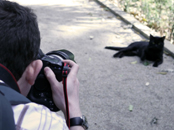04 December 2018
83% vets say they are concerned about the inappropriate representation of animals in adverts, with insurance companies, pet food brands, supermarkets and banks topping the list of most-cited ‘bad-ad' culprits
There was a time when a baby promoting a
pack of cigarettes or dressed-up chimps hawking tea were viewed as par for the
course. Now vets are hoping that similarly inappropriate images of pets
disappear from our television screens, billboards and social media channels.
The
UK's leading veterinary organisations say it's time to address the
irresponsible depiction of our furry friends across all forms of advertising to tackle the concerning normalisation of poor animal health
and welfare.
British Veterinary Association (BVA) President
Simon Doherty said,
“Images of cute, funny and cuddly pets grab
our attention and pull at our heartstrings, so it's no surprise that
advertisers use them to be the face of their brand. While the individual pets
in the adverts might be well-cared-for, our concern is with the way they are
often depicted and its impact on the wider pet population.
“Often the welfare issues affecting the
animals are not immediately obvious to an untrained eye, but we know vets and
vet nurses are very concerned by issues such as the normalisation of potentially
harmful or misleading behaviour and the use of popular breeds who suffer because
of the way they have been bred. We hope all advertisers will adopt our new guidance,
so that images of trampolining Boxers and flying pugs played for laughs will be
relegated to advertising history books.”
Pets in ads: A social concern
To help companies big and small avoid similar
pet promo pitfalls and harness the power of advertising to promote positive
animal health and welfare across a range of species, BVA has launched an authoritative set of
pet advertising guidelines today, with support from members of the Veterinary Animal Welfare Coalition.
BVA's guidelines, Pets in advertising: A social concern, identify good practice
guidance as well as common mistakes in portraying pets, whether real or cartoon
and computer-generated (CGI), across each of the five animal welfare needs set
out in the UK Animal Welfare Acts. These include the
need for a suitable environment and diet, ability to exhibit normal behaviour,
the need to be housed with, or apart from, other animals, and lastly, to be
protected from pain, suffering, injury or disease. Thus, images of pets
consuming potentially toxic food such as chocolate or raisins, children
‘riding' dogs, rabbits
housed in tiny hutches, teacup animals and dogs with cropped ears or docked tails are all examples that
should be avoided.
Concerning statistics
Eight in ten vets in the UK (83%) say
they are concerned about the inappropriate representation of animals in
adverts, with insurance companies, pet food brands, supermarkets and
banks topping the list of most-cited ‘bad-ad' culprits by vets,
BVA's Voice of the Veterinary Profession survey reveals. More
than two in five vets (44%) recalled seeing adverts over the past month that featured
images of pet animals unable to exhibit normal behaviour, depicted in an unsafe
scenario (31%), or shown in an unsuitable environment (24%), among other
concerns.
By far the most commonly cited adverts, seen by
more than three-quarters of vets, were those that showed pets with exaggerated
features or extreme conformation, such as pugs or Persian cats. BVA's
#BreedtoBreathe campaign this year has highlighted how sustained efforts by
concerned members of the public and the veterinary profession can help, as big
brands including Marks & Spencer, HSBC and Lidl have pledged not to use
images of flat-faced dogs in ads or on social media in the future.
Simon Doherty added,
“We
know there's a public appetite for responsible portrayal of pets in adverts, as
witnessed by the success of our #BreedtoBreathe campaign and the high volume of
complaints that the Advertising Standards Authority receives each year by viewers
concerned about misleading, distressing or harmful depictions of pets in ads.
“Christmas has traditionally been a time
when emotionally charged adverts featuring inappropriate portrayals of our
furry friends flash across our television screens or social media timelines. We
are pleased to see that so far this year the big brands haven't gone down this
road, and hope they'll engage with our good practice guidelines and understand
that pets deserve to be depicted responsibly this season and all year round.
“Our guidelines also give animal lovers
and pet owners across the country an easy reference to assess portrayals of pets
in ads, and we would encourage them to join us in
alerting brands who inadvertently use inappropriate images in their campaigns.”
For members of public or the veterinary profession concerned by any adverts,
BVA has developed a template letter to flag concerns to the brands in question.
How veterinary practices can engage with the campaign
In addition to asking advertisers to avoid inappropriate portrayal of pets, BVA believes veterinary practices can also play a role in encouraging
responsible pet ownership and positive animal health and welfare outcomes through their marketing channels.
The
Veterinary Marketing Association (VMA) has announced that it will be adding
BVA's new pet advertising guidelines for consideration across its judging
criteria for all future VMA Annual Awards.
If
you are unsure of any of the guidance set out in this document or have a query
that is not addressed, please contact BVA at policy@bva.co.uk.
Veterinary Animal Welfare Coalition
The Veterinary Animal Welfare Coalition was formed to meet the recommendations in the Vet Futures project and aims to deliver awareness raising and behaviour change communication campaigns, based around responsible pet ownership and the five welfare needs as outlined in the Animal Welfare Acts. It
comprises the British Small Animal Veterinary Association, British Veterinary
Zoological Society, British Veterinary Nursing Association, Blue Cross, PDSA,
RSPCA and the Scottish SPCA



